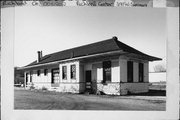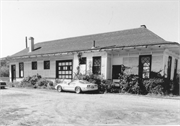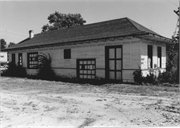Property Record
391 W SEMINARY ST
Architecture and History Inventory
| Historic Name: | CHICAGO, MILWAUKEE AND ST. PAUL RAILROAD DEPOT |
|---|---|
| Other Name: | WISCONSIN WESTERN RAILROAD COMPANY |
| Contributing: | |
| Reference Number: | 51202 |
| Location (Address): | 391 W SEMINARY ST |
|---|---|
| County: | Richland |
| City: | Richland Center |
| Township/Village: | |
| Unincorporated Community: | |
| Town: | |
| Range: | |
| Direction: | |
| Section: | |
| Quarter Section: | |
| Quarter/Quarter Section: |
| Year Built: | 1910 |
|---|---|
| Additions: | |
| Survey Date: | 1995 |
| Historic Use: | depot |
| Architectural Style: | Craftsman |
| Structural System: | |
| Wall Material: | Clapboard |
| Architect: | |
| Other Buildings On Site: | |
| Demolished?: | No |
| Demolished Date: |
| National/State Register Listing Name: | Not listed |
|---|---|
| National Register Listing Date: | |
| State Register Listing Date: |
| Additional Information: | A 'site file' exists for this property. It contains additional information such as correspondence, newspaper clippings, or historical information. It is a public record and may be viewed in person at the State Historical Society, Division of Historic Preservation. Architectural Description: Exposed rafter ends; diamond shaped window panes over clear plate glass; stick ornamentation; projecting east bay; service doors added to west side. Covered by horizontal wood siding given the appearance of base through the use of a wooden belt course below the window sill, this Craftsman influenced depot is further characterized by diamond paned glazing in the upper window sashes, and false exposed rafter ends under the eaves. The depot has been altered by the addition of service doors to the east and west elevations. Built in 1909 as a passanger depot for the Chicago, Milwaukee and St. Paul Railroad, the depot, now abandoned along with the railroad service into Richland Center, was later used by the Wisconsin Western Railroad Company (ABC). Architectural/Engineering Significance: The Chicago, Milwaukee and St. Paul Passanger Depot is significant under Criterion C as the sole remaining example of a type of architecture in Richland Center. Significant as the only representative of architecture associated with the railroad remaining in the city, the depot is characterized by architectural details such as exposed rafter ends and by an emphasis on structural parts that is generally associated with the Craftsman movement. Built in 1909 for the the Chicago, Milwaukee and St. Paul Railroad, who took over the small spur line intially established in 1875 through a great deal of effort by the citizens of Richland Center, this depot is in danger because no substantial reuse of the building has occurred since the railroad line to the city was discontinued (AB). Historical Background: In 1870, the state legislature authorized the formation of a local corporation to construct the Pine River and Stevens Point Railroad which was originally planned to extend from Lone Rock to Stevens Point through Richland Center. Promoters decided on the Lone Rock to Richland Center leg in 1872. Financing was derived from both individual and local municipal subscriptions. George Krouskop served as president of the corporation while N.L. James guided its construction as general manager of the stock company. He furnished the wooden rails upon which the road ran. Beginning in 1875, construction proceeded from Richland Center to Lone Rock ending in 1876. When financial problems arose in 1878, the railroad was sold to the Chicago, Milwauke and St. Paul. The company installed a standard gauge steel track (1). Probably constructed between 1876 and 1878, the first depot was located at the northwest corner of Main and Haseltine. Built by the Chicago, Milwaukee and St. Paul, the second depot was erected at the corner of Haseltine and Second in 1878c. After an 1882 explosion, the third depot was placed on the west side of the tracks along Orange Street. By 1906, community businessmen lobbied for a new depot. D.G. James finally secured a promise from the railroad in 1909. The new depot was placed on the east side of the tracks at the southwest corner of West Seminary and South Jefferson in that year. The new depot became the passenger depot and the 1882 ediface served as the freight depot (2). By 1917, three to four trains served Richland Center. This service declined by the late 1920s as bus transportation began to replace the train (3). Historical Significance: The depot gains local historical significance under Criterion A in association with the Later Railroad Topic of the Transportation Theme. Railroad construction expanded rapidly after 1875 peaking from 1879 to 1884 and lasting to 1894. During this period of building, railroad control shifted from local entrepeneurs to outside control by large companies. In the late nineteenth century, many communities which received such connections prospered and often boomed. But this prosperity later subsided because the railroad tended to concentrate activities along specific routes at key points thus focusing commercial activity and allowing limited industrial activity at most locations. Local trade often peaked before completion of the process (4). Richland Center's growth and florescence parallels this pattern showing its greatest expansion from the late 1870s to the early 1890s and in the early twentieth century after the 1890s depression when the depot was erected. The depot's period significance extends from its erection in 1909 to the gradual cessation of traffic in the late 1920s which approximately parrallels this second period of expansion. |
|---|---|
| Bibliographic References: | Richland Observer 3/20/1997. 1. C.W. Butterfield, History of Crawford and Richland Counties (Springfield: Union Publishing Company, 1884), pp. 948, 1191; Margaret Scott, Richland Center: A History (Richland Center: Richland County Publishers, 1972), pp. 54, 82-84; Republican Observer, January 1, 1938, p. 8. 2. Scott, Ibid., pp. 55, 73, 84, 116, 140; Democrat, July 28, 1909; Francis Brewer, Home for the Heart, An Intimate History (Richland Center: Francis L. Brewer, 1977), p. 291. 3. Scott, Ibid., p. 191. 4. Barbara Wyatt, Cultural Resource Management of Wisconsin (Madison: Historic Preservation Division, SHS, 1986), [Transportation], II, 6-2; Robert Nesbit, The History of Wisconsin: Urbanization and Industrialization, 1873-1893 (Madison: SHS, 1985), p. 146. A. Margaret Scott, Interview with Joan Rausch, 15 January 1988. B. Margaret H. Scott, Richland Center, Wisconsin, A History (Richland Center: Richland County Publishing, 1972), pp. 84, 124, 56. C. Inscription. Richland Center Observer 2/5/1998. |
| Wisconsin Architecture and History Inventory, State Historic Preservation Office, Wisconsin Historical Society, Madison, Wisconsin |





